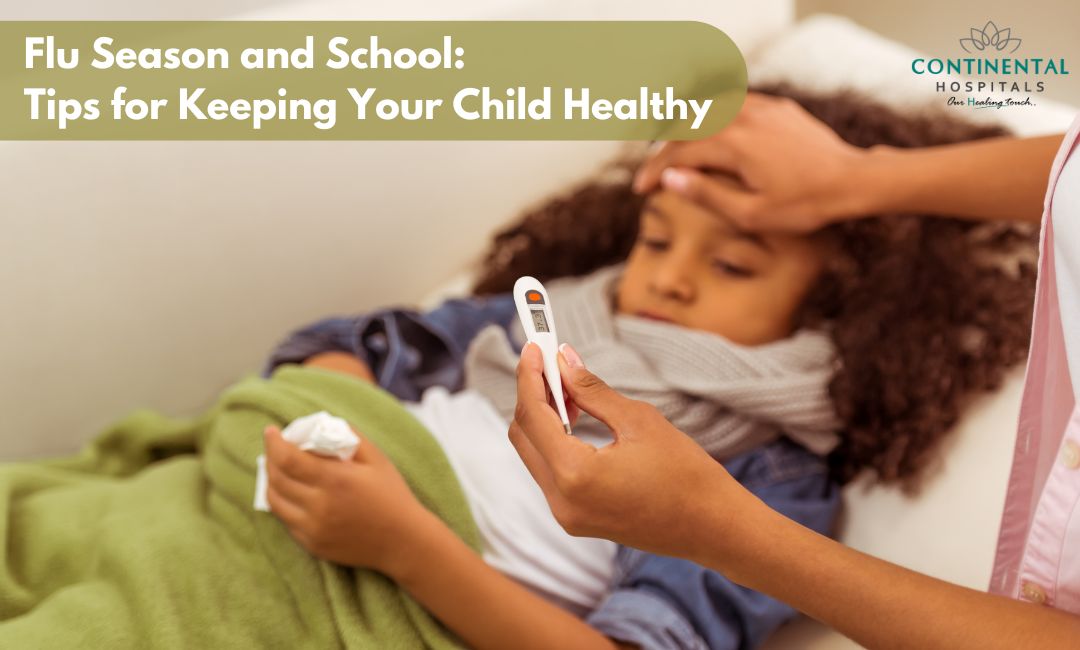Every year, flu season brings a wave of sniffles, coughs, and fevers, often hitting schools particularly hard. As a parent, it's natural to worry about your child catching the flu and falling behind in school. But fear not! By taking proactive steps and building good habits, you can significantly reduce your child's risk of getting sick and ensure a smooth school year.
Understanding the Flu:
The flu, or influenza, is a highly contagious respiratory illness caused by influenza viruses. These viruses can spread easily through coughs, sneezes, and close contact with an infected person. Symptoms typically appear within 1-4 days of exposure and can include:
- Fever or chills
- Cough
- Sore throat
- Runny or stuffy nose
- Muscle aches and fatigue
- Headache
- Vomiting and diarrhea (more common in children)
The flu usually lasts for 3-7 days, but it can leave you feeling weak for a couple of weeks. While most people recover without complications, some, especially young children, older adults, and pregnant women, are at higher risk of developing serious flu-related complications like pneumonia.
🥗 Healthy Plate Challenge
🍽 Add Your Favorite Dish
Pick Your 6 favorite foods, eat, and see the results.Drag & drop foods onto your plate.
Drop Food Here
Consult with a Pediatrician to know more about the Flu symptoms and home remedies to follow.
Importance of Prevention:
Prevention plays a crucial role in mitigating the impact of flu season, particularly within school environments where children are near one another. Here are several reasons why prevention is of paramount importance:
Reducing Transmission: The flu virus spreads easily from person to person, especially in crowded places like schools. By implementing preventive measures, such as hand hygiene and respiratory etiquette, individuals can minimize the transmission of the virus to others, thus preventing outbreaks within the school community.
Protecting Vulnerable Populations: Children, particularly those with underlying health conditions or weakened immune systems, are more susceptible to complications from the flu. Prevention efforts, including vaccination and staying home when sick, help protect vulnerable populations from severe illness and potential hospitalization.
Minimizing Absenteeism: Flu-related absenteeism can disrupt the learning process and impact academic performance. By promoting preventive measures, schools can reduce the number of sick days taken by students and staff, ensuring continuity in education and productivity.
Alleviating Strain on Healthcare Systems: During flu season, healthcare facilities often experience increased demand for medical services, including doctor's visits, emergency room visits, and hospitalizations. By preventing the spread of the flu, individuals can alleviate the strain on healthcare systems, ensuring that resources are available for those in need of medical attention.
Preventing Complications: In addition to the immediate symptoms of the flu, such as fever, cough, and fatigue, the virus can lead to complications such as pneumonia, bronchitis, and sinus infections. Prevention measures help reduce the likelihood of flu-related complications, promoting overall health and well-being.
Contributing to Public Health: Individual efforts to prevent the flu have broader implications for public health. By vaccinating, practicing good hygiene, and staying home when sick, individuals contribute to the collective goal of reducing the spread of infectious diseases within communities and protecting individuals of all ages and backgrounds.
Addressing Dual Threats: With the ongoing COVID-19 pandemic, the importance of prevention is amplified as individuals and communities navigate the challenges of flu season alongside the risks posed by the coronavirus. Preventive measures that reduce the spread of the flu can also help mitigate the transmission of COVID-19, safeguarding public health on multiple fronts.
Tips for Keeping Your Child Healthy During Flu Season:
Promote Hand Hygiene: Teach your child the importance of frequent handwashing with soap and water for at least 20 seconds, especially after using the restroom, before eating, and after coughing or sneezing. If soap and water are not available, use hand sanitizer with at least 60% alcohol.
Practice Respiratory Etiquette: Encourage your child to cover their mouth and nose with a tissue or their elbow when coughing or sneezing to prevent the spread of respiratory droplets. Discourage them from touching their face, particularly their eyes, nose, and mouth, to minimize the risk of transferring germs.
Maintain a Healthy Lifestyle: Ensure your child gets adequate sleep, eats a balanced diet rich in fruits and vegetables, and engages in regular physical activity. A strong immune system can better defend against infections, including the flu.
Keep Vaccinations Up to Date: In addition to the flu vaccine, ensure your child is up to date on all recommended vaccinations, including those for measles, mumps, rubella, and whooping cough. Vaccinations help protect against preventable diseases and contribute to herd immunity within the community.
Stay Home When Sick: Teach your child the importance of staying home from school when they are sick to prevent spreading illness to others. Fever, cough, sore throat, body aches, and fatigue are common symptoms of the flu. Keep them home until they are fever-free for at least 24 hours without the use of fever-reducing medications.
Disinfect Frequently Touched Surfaces: Regularly clean and disinfect commonly touched surfaces and objects, such as doorknobs, light switches, desks, and electronic devices, to reduce the spread of germs in the home and school environment.
Encourage Good Hydration: Ensure your child drinks plenty of fluids, such as water, herbal teas, and diluted fruit juices, to stay hydrated and support overall health. Proper hydration can help flush toxins from the body and maintain optimal immune function.
Support Mental Health: Flu season and the ongoing pandemic can be stressful for children, causing anxiety and uncertainty. Maintain open communication with your child, listen to their concerns, and provide reassurance and support. Encourage activities that promote relaxation and emotional well-being, such as mindfulness exercises, creative outlets, and spending time outdoors.
Flu season presents unique challenges for parents and guardians, particularly when it comes to keeping children healthy in school settings. By implementing preventive measures such as promoting hand hygiene, practicing respiratory etiquette, maintaining a healthy lifestyle, staying up to date on vaccinations, and supporting mental health, you can help reduce the risk of flu transmission and protect your child's well-being. Remember, leading by example and fostering good habits at home can empower your child to prioritize their health and make informed decisions, not only during flu season but year-round.
Consult with a Pediatrician to know more about the Flu symptoms and home remedies to follow.
Related Blog Articles-
1. Adult Vaccination: Which do you need?
2. HPV Vaccine: A Powerful Tool in Preventing Cervical Cancer
3. Importance of Polio Vaccination: Why Every Child Needs to Be Immunized
.webp)














